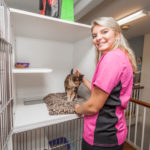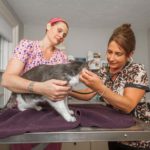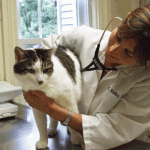Planes, Trains and a Pet Sitter

Finding a Pet Sitter
My husband and I love to travel. We love vacations by the beach…. in February. As a New Englander this always involves travel. One of the most stressful parts of planning a trip is what to do with the cats, the dog and the fish. We usually try to get a pet sitter. We always have multiple cats, sometimes multiple dogs and sometimes other critters. It just seemed less stressful for someone to come in to the house and let everyone stay in their preferred environment. But who should that person be? A professional? A neighbor? A friend? A colleague?
Pet Sitter of Our Dreams
We were lucky many years ago to come across a veterinary technician that worked with my husband who fit the bill for our pet sitter. She was young, unattached and willing to stay away from her parents’ house for a vacation of her own. She was also extremely reliable and very concerned for our pet’s well-being. I knew nothing would happen under her watch.
This gave us a sense of security. We always scheduled our pet sitter before making plans of our own. But how long would this last? Luckily for us it lasted many years until one day she found the man of her dreams. Great for her! But I am thinking that she will no longer want to leave her home of wedding bliss to stay with my pets!
Boarding VS Pet Sitter
Now the dilemma begins again. We found several professional pet sitters that came highly recommended. We also had the option of boarding our pets.

Luckily, the Cat Clinic of Plymouth offers boarding for cats only. The facility is great! Clean, quiet and offers multiple options for boarding areas. There are large multi-level condos available with cubicles to hide in. They either face the sunny windows with birds flying to and fro or they face the kitchen area for those social cats that want pats every time an employee walks by. There is also a horizontal condo with two sides that the cat can access for those elderly or less nimble cats that want to stretch their legs but don’t want to jump. And suitable for our multi-cat situation there are entire rooms that can be rented allowing a family of cats to stay together. Some of these even have ocean views!
This seemed like the best option for us. The only issue was… the dog! (Yes the cat vet owns a dog.) I mean she is a tiny dog, but I think the staff would figure it out meaning little Luna would have to stay at another boarding facility all by herself. So either the family is divided or we come up with another option. And the fish! Is there a fish boarding facility?
Cat Only Boarding
So if your family is made up of just human travelers and cats, we have the answer for you at the Cat Clinic of Plymouth. Let us take your cats on vacation for some pampering while you enjoy your travels. Come check out our cat only boarding facility at the Cat Clinic of Plymouth.
Post Script: A veterinary technician of mine fell into circumstances where she was available and willing to be our pet sitter. A big sigh of relief, at least for now.
By Cassandra Kelley DVM, veterinarian and owner Cat Clinic of Plymouth








